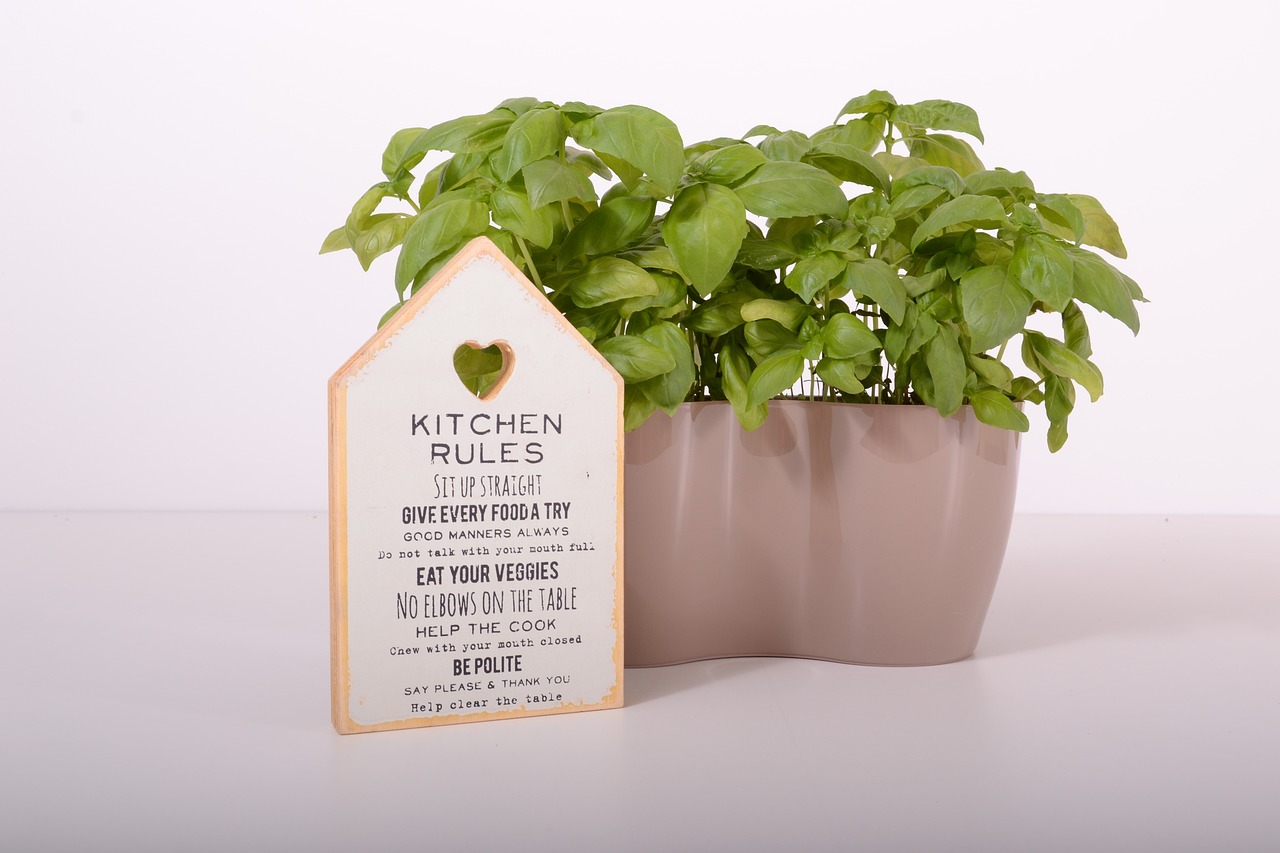
Table of Contents
Growing herbs indoors is a great way to have healthy fortifying plants if you are limited to garden space. Not only is it rewarding with herbs adding fragrance and a pop of greenery to your home, but it will be a feature that will impress your friends. Most of all you will have convenient access to herbs for your culinary uses.
If you are looking to raise an edible garden inside your home, keep reading to find out about the 8 best herbs you can grow indoors and the benefits of an indoor herb garden.
Benefits of Growing Herbs Indoors

Indoor plants make your home a sanctuary. They add a holistically healing aspect to physical and mental well-being, especially in today’s modern and digitalized world where lives are busy with hectic routines. One of the easiest ways to add plants to your home is by growing your own herbs indoors. Let’s have a look at some of these:
- You will have access to homegrown fresh produce and there is nothing like fresh herbs in your kitchen.
- Growing your herbs indoors will ensure you have an all-year-round supply of fresh herbs as the outdoor environmental elements will not affect your herbs.
- Herbs are low maintenance to grow and all you need to do is remember their watering and light requirements.
- Growing your own herbs will be cost-effective as herbs tend to be costly if you buy them from the supermarket.
- Having access to a variety of fresh herbs will boost the flavor and goodness in your meals.
- Herbs will add to your indoor aesthetics.
What to Consider When Growing an Indoor Herb Garden
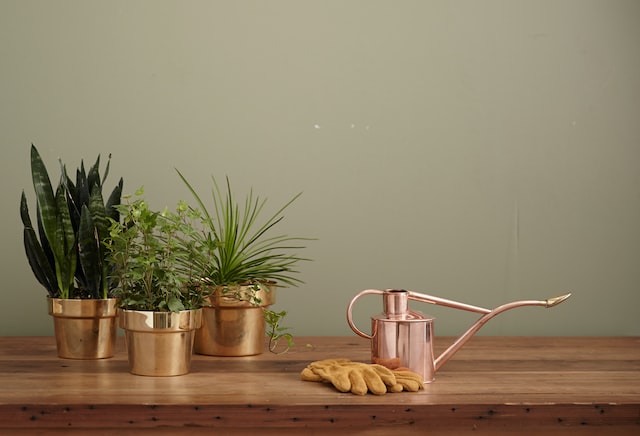
To grow herbs indoors, there are a few things that you’ll need to take into consideration.
The foremost thing is to ensure that the room has access to sunlight. Most herbs require 6 – 8 hours of sunlight daily. Placing your herbs near a well-lit window or using grow lights will be the best option if your herbs are growing into leggy plants.
The amount of sunlight varies depending on the herbs you plant so choosing the herbs that thrive indoors will limit light.
Herbs tend to like warm temperatures and humidity. Creating these environments indoors might be a challenge. You can mist your herbs and place them on a water-filled tray of pebbles to create some humidity, but these situations need to be monitored and managed.
Choose pots and planters that have a good drainage system. Water as needed when the topsoil is dry and avoid water logging that can cause root rot. Watch out for pests as they can be a problem.
8 Best Herbs to Grow Indoors
1. Basil
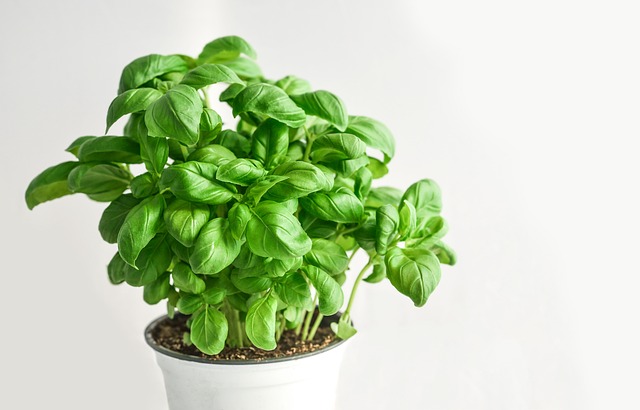
Basil (Ocimum basilicum) is one of the handiest herbs to grow and does well indoors. There are many recipes that use fresh basil. A key ingredient in Italian cuisine, basil has many health benefits and can be used in many ways like salads, sandwiches, sauces, and pizza.
Remember to provide adequate moisture and sunlight by placing it near a sunny well-lit window. South-facing windows will be the ideal location if not use a grow light.
- Type of Pot: A deep pot is an appropriate choice to grow basil, to maintain good drainage and moisture retention.
- Soil: Use nutrient-rich, well-draining soil with pH of 6 – 7.
- Planting: Spread some basil seeds and lightly cover with moistened potting mix. Use a mister to keep the soil moist.
- Sunlight & Humidity: Place the pot at a window that will provide sunlight during the day and consistently warm temperatures at night. You will notice that the seedlings will start to lean toward the light. Rotate the pots so that they won’t lean in one direction. If you notice the plants being leggy, it means there isn’t adequate sunlight. You might need to use a grow light. Set the grow light on a timer and place it close to the plants. If the plants develop white spots on the leaves, move the grow light a little higher so the light isn’t too intense on the plants.
- Water: Remember to keep the soil moistened.
- Fertilizer: Feed basil with a nutrient-rich organic fertilizer every 4 – 6 weeks.
- Care: If the pots seem crowded with extra seedlings growing, cut these and use in a salad. The tops of the plant should be frequently pinched to encourage fuller growth. Pinch basil flowers immediately to encourage growth.
If you’re interested in learning more about this herb, check out our other articles: How to Grow and Care for Basil, How to Use Basil Flowers – A Brief Guide, 11 Basil Varieties – For Your Home and Garden.
2. Chervil
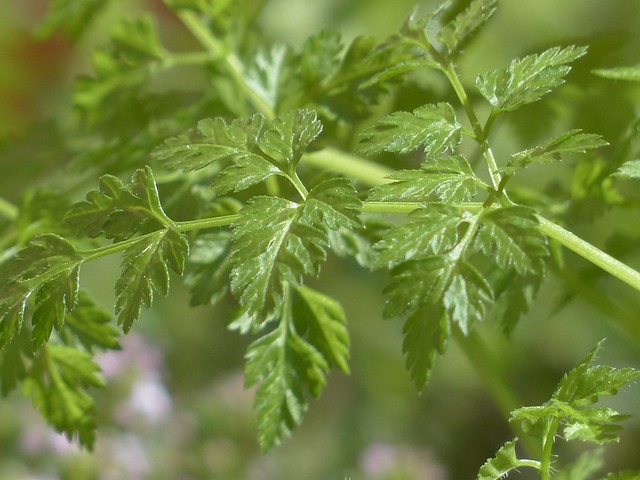
Chervil (Anthriscus cerefolium) proves to be the right choice to grow indoors as it doesn’t like hot summers or intense sunlight. Also known as French parsley, chervil is an annual herb that is easy to grow for beginner gardeners.
This herb has a very delicious taste that can be added to salads, roast chicken, vinaigrette, and egg dishes. The best time to grow is spring or late summer. Follow these easy steps to get your basil thriving indoors:
- Type of Pot: As chervil have long tap roots, it’s best to choose a big container to plant it in.
- Soil: Fill humus rich loamy potting soil with peat moss which will retain moisture for longer. Prefers fertile soil with pH 6.5 – 7.
- Planting: Sow the seeds onto soil in 1cm trenches 30 cm apart. Seedlings will start to grow from 14 – 28 days. Thin out seedlings once they start growing, allowing 10 inches of space in between plants.
- Sunlight & Humidity: Place in a cool shady spot. If temperatures are too high, your chervil will bolt early.
- Water: Water chervil regularly. Remember to keep the soil moistened.
- Fertilizer: As chervil has a short life span, fertilize at the planting stage which should be sufficient.
- Care: Prune chervil regularly to prevent it from bolting. Watch out for pests even though it’s indoors. If you want fresh young leaves frequently, replant them every few weeks.
3. Chives
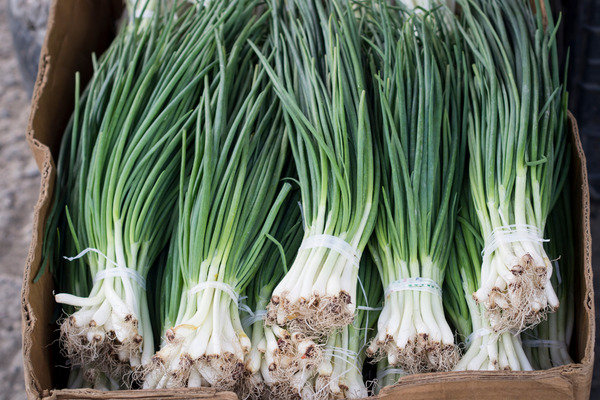
Chives (Allium schoenoprasum) are an easy-to-grow herb that has a light onion flavor. A prominent feature of this herb is its attractive flowers that can be used in garnishing. Chives are well-loved in stir-fries, soups, salads, and for garnishing.
You can easily grow chives indoors if you place them near a sunny window that offers 6-8 hours of sunlight which chives love. Follow these easy steps to get your basil thriving indoors:
- Type of Pot: Use a pot that has good drainage holes.
- Soil: Prepare a pre-moistened potting medium that will form into a ball when squeezed. Chives prefer soil with a pH level of 6 – 7.
- Planting: Sow chives seeds straight onto soil. Spread the seeds over ¼ inch into the soil.
- Sunlight & Humidity: Place the pot near a well-lit window as chives can thrive in full or partial sun. Rotate the plant so it doesn’t direct towards sunlight.
- Water: Remember to keep the soil moistened and water once a week.
- Fertilizer: Have the soil fertilized at planting time, which should be enough. Too much fertilizer can affect the taste of chives.
- Care: Chives can be harvested when the plant is about 6 inches high. Cut chives at the base removing the entire length of the leaf. Trimming chives this way encourages new growth.
4. Rosemary
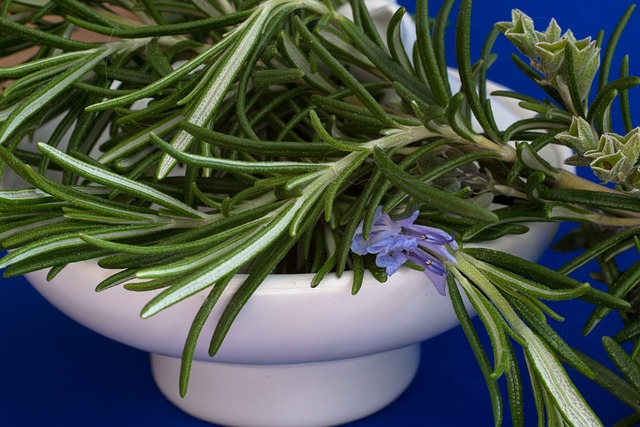
Rosemary (Salvia rosmarinusis) does well when growing outdoors but with the right attention and care, you can have rosemary indoors. A distinctive feature of rosemary is that it has needle-shaped leaves that have a charming fragrance. It smells like a natural air freshener and will add a soothing fragrance to your home.
Rosemary leaves are used in many roast dishes and are popular for their many health benefits.
- Type of Pot: This herb becomes relatively large and woody over time, so a big pot would be suitable for it.
- Soil: Needs 6-8 hours of direct sunlight so placing it near a well-lit window will help your rosemary get the required sunlight. For seeds, use a seed starting mix.
- Planting: Using a seed starting try with a plastic humidity done is an ideal way to help your rosemary seeds to grow. Sow the seeds over the seed-starting mix and cover lightly.
- Sunlight & Humidity: Place the pot in a sunny and warm location with direct sunlight. Rosemary is a herb that likes high humidity. To tackle its tendency, you can build a tent around your rosemary to trap moisture. The growing process is to install stakes in the pot, and cover the stakes with clear plastic. You can lift the plastic to gain access when watering. With the help of evaporation, the tent will trap it and increase humidity.
- Water: Rosemary is a drought-resistant plant so water it when the topsoil is dry, once a week in summer, every two weeks in spring and fall.
- Fertilizer: Rosemary is a hardy plant and won’t need fertilizer. However, if the tips of the leaves look dry, then a 10-10-10 NPK fertilizer will help.
- Care: When harvesting rosemary, use sharp scissors to cut. Monitor for pests and diseases. Harvest before rosemary blooms.
5. Oregano
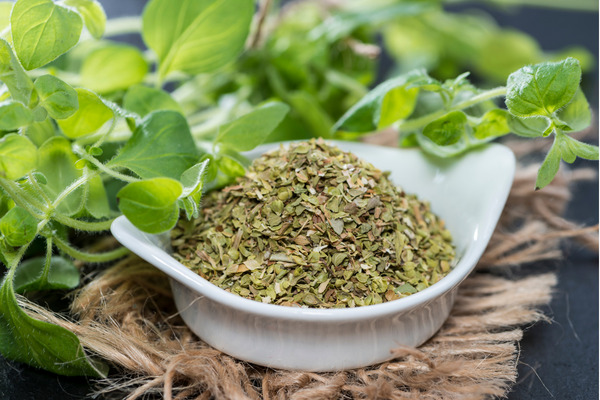
Oregano (Origanum vulgare) belongs to the mint family. The prominent feature is that it doesn’t require much water. It won’t require water until the soil feels dry to the touch. Frequent trimming will keep your plant healthy and nourishing. Oregano can be added to tomato sauces, meat, casseroles, soups and stews. If you dry its leaves, they would be more pungent than fresh.
- Type of Pot: Terra cotta or clay pots where the porous helps drain and keep soil dry.
- Soil: Prefers loam, chalk, or sandy soil which is well-drained with dry to medium-moisture levels.
- Planting: Oregano can be grown from seed or rooted cuttings. To root a cutting, take a tip that has been cut from an outdoor oregano plant. After it has been planted in a pot, place it in a south-facing window.
- Sunlight & Humidity: Needs 6-8 hours of sunlight daily so place the pot near a well-lit window or use a plant light placed 5-6 inches away.
- Water: Water when topsoil is dry. Saturate the plant by watering it so that all roots can get watered.
- Fertilizer: Oregano is a hardy plant and needs fertilizer only at the planting stage.
- Care: Prune oregano to remove any access or wayward growth. Harvest regularly to encourage new growth.
6. Mint
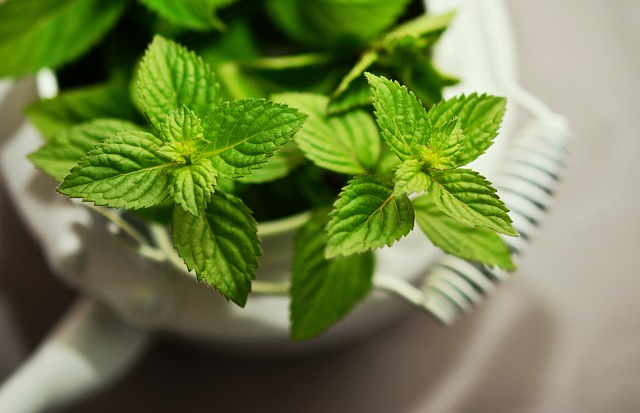
Mint (Mentha spp.), a hardy perennial, is one of the most popular and useful herbs. Its fragrant stems and minty leaves make it attractive to grow indoors. There are many varieties of mint available like peppermint, spearmint, chocolate, orange, apple, banana with versatile usage.
Spearmint would be appropriate in savory recipes. For desserts, chocolate-mint and apple-mint are great. The refreshing taste of peppermint enhances the charm of candies and ice cream. Mint can also be added to make remarkable tea and vast range of drinks. Although mint is a sun-loving herb, it can be grown indoors with the right care.
To grow mints inside a house, keep the soil moist and give them moderate to strong light. The inside plant requires frequent watering.
- Type of Pot: A sunken pot as mint tends to grow as an invasive plant.
- Soil: Use soil rich in organic matter and one that has a pH level of 6-7.5.
- Planting: Sow mint seeds ¼ inches deep and cover lightly with soil. Seeds will germinate in 7 – 14 days. Transplant the seedlings.
- Sunlight & Humidity: Mint likes full sun or partial shade so placing your mint near a sunny window would be a good idea.
- Water: Water mint only if the topsoil is dry. However, when watering an indoor mint plant, take it to the sink and water it thoroughly till the water starts to drain from the holes at the bottom of the pot.
- Fertilizer: Use a NPK 16-16-16 fertilizer when new growth emerges.
- Care: Regularly harvest by pinching the leaves off the stems for a bushier plant. Cut it back in half if it looks spindly.
7. Bay Laurel
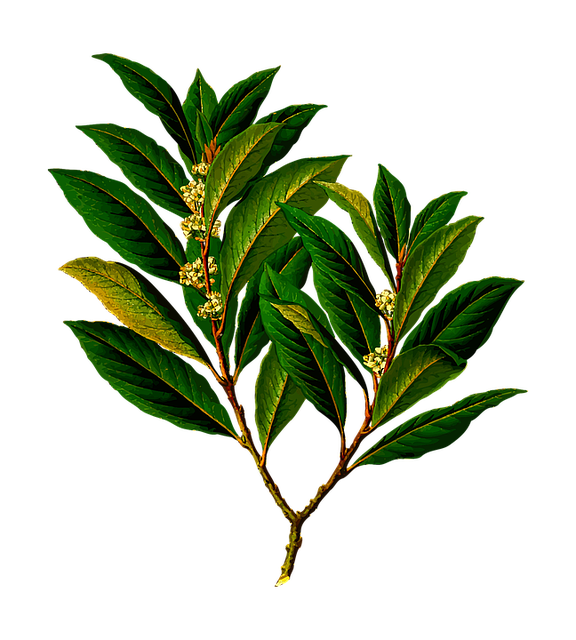
Bay laurel (Laurus nobilis) is a great herb for container gardening. It is a hardy drought-tolerant plant that is low maintenance and one of the longest cultivate trees.
The growing process starts with picking leaves and drying them for storage. Keep in mind that the oldest leaves have the strongest flavor., and place the pot in an east- or west-facing window. Bay laurel needs good air circulation, as it helps prevent disease. The use of bay laurel’s leaves is to flavor stews, soups, and sauces. It can also be used to make a fragrant, fresh-smelling wreath.
- Type of Pot: A 24-inch pot will suit a bay laurel that will grow up to around 6 ft. Can use a 5-gallon pot or larger as well.
- Soil: Plant the herb in fast-draining soil. For planting with seeds, use a soilless seed starting medium.
- Planting: Bay laurel can be propagated from a 6-inch cutting. Use a rooting hormone to dip the cuttings in and plant in sandy soil. To plant with seeds, spread the seeds inside a plastic bag and lightly cover it with a soilless seed starting medium, allow air to move through the bag, and keep in an area with 40F temperature to germinate.
- Sunlight & Humidity: Place your bay laurel in a place it can receive full sun in cold climates and in hotter zones, partial shade will be suitable.
- Water: Will tolerate waterlogging, but water only when topsoil is dry.
- Fertilizer: Not a nutrient needing plant.
- Care: Be conscious about shield-like scale insects on leaves and stems. Regular trimmings will keep your bay laurel compact.
8. Thyme
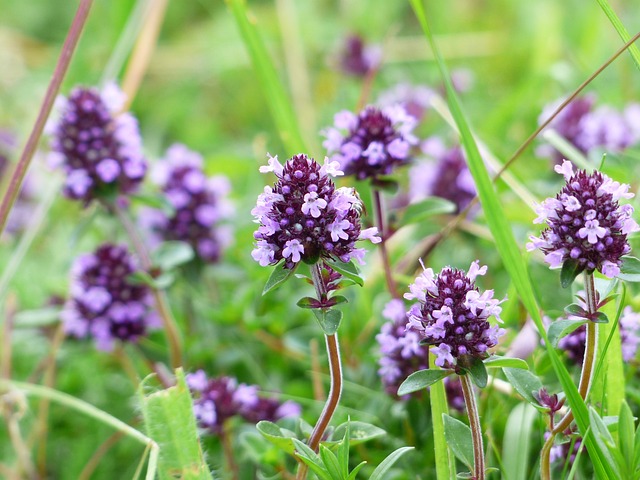
Thyme is a herb that loves heat. There are three types of thyme with the first and most common variety called French or English thyme. Lemon thyme comes next and the third type is called the caraway thyme.
To plant thyme indoors, consider the light availability in your home. For growing thyme soil should be well-drained, it can be accompanied by drought-tolerant herbs. Thyme can be grown with rosemary, as it also demands sunny conditions. Thyme has a really gentle, floral flavor. It can be added to several dishes like meats, soups, beans, and potatoes.
- Type of Pot: A clay pot that will allow thyme to dry in between watering.
- Soil: Alkaline and well-drained soil.
- Planting: Planting it through seeds doesn’t work well because of the low germination process. You will have to plant the cuttings indoors 6 to 10 weeks before the frost. The plants attain a height of 6 to 12 inches.
- Sunlight & Humidity: Place the thyme near a well-lit window as thyme loves sunshine.
- Water: Water your thyme every 10 – 15 days.
- Fertilizer: Feed thyme every summer with a liquid feeder high in potash.
- Care: The plants attain a height of 6 to 12 inches.
Frequently Asked Questions about Growing Herbs Indoors
Basil, chives, mint, thyme, cilantro, parsley, rosemary, oregano, lavender, and dill are some herbs that grow well indoors.
Yes, many herbs can be grown indoors year-round with proper care. Some herbs, such as basil and cilantro, may have shorter lifespans and need to be replaced more frequently, while others, such as rosemary and thyme, can last for several years.
Basil and mint should not be potted together because mint tends to take over and crowd out other plants. In addition, herbs such as dill and fennel should not be potted with other plants because they may attract pests that could harm the other herbs.
The lifespan of potted herbs depends on the type of herb and the care it receives. Some herbs, such as basil and cilantro, may have shorter lifespans and need to be replaced more frequently, while others, such as rosemary and thyme, can last for several years.
The frequency of watering herbs indoors depends on the type of herb and the size of the pot. In general, herbs should be watered when the soil feels dry to the touch.
Some herbs, such as chives, mint, oregano, rosemary, and thyme, are perennial, which means that they come back each year and can last for several years with proper care.
Wrapping Up
Herbs are plants that can be used in several ways, ranging from culinary to medicinal purposes. Now that you are aware of some of the benefits of indoor herb gardening along with some of the best easy-to-care herbs, it might be a good idea to grab some seeds and get started.






